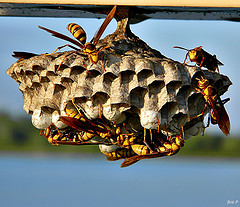What To Do If Bees Attack You Or Your Dog
Posted on April 6, 2015 by Joy of Living No comments

It’s not unusual this time of year to find wasp nests or bee hives with lots of activity. If your dog hasn’t ever encountered these insects, he may be curious and want to check out the nest. Definitely a bad idea! The April 2015 issue of Whole Dog Journal offers these tips on what to do if bees attack you or your dog:
- The first order of business is to get away from the nest/hive as quickly as possible. Avoid loud noises, especially shouting.
- Do not disturb the nest/hive.
- Don’t swat at the bees or wasps, this will only aggravate them.
- If a few wasps or bees dive bomb you, this is their warning to you to leave ASAP.
- Start running if the insects come after you. If your dog is small enough, pick him up and run, otherwise, make sure your dog is running alongside you. You can usually outrun the insects, but a few stubborn hangers-on may come after you a second time, so be prepared to run again if needed.
- If there’s a wind, run into it, this will inhibit the bug’s flight.
- Protect your face. If carrying your dog, cuddle him as close as possible to you while running.
- Don’t stop running until you’re sure the bees/wasps have given up chasing you.
- Avoid hiding in water. Often bees/wasps will swarm and wait for you.
If this is your dog’s first encounter with bees/wasps, you probably won’t know if he’s allergic to the venom. It may be hard to tell if he was stung, and if he was, how many stings he may have gotten. Stings usually happen in the least hairy area of your dog, like his underbelly or around his nose.
Watch for signs of reactions to the stings. Reactions will usually begin immediately, with swelling the predominant first sign. If you suspect your dog has multiple stings, and swelling is severe, get him to an emergency vet as soon as possible for treatment. Other signs of serious reaction include: breathing difficulty, pale gums, drooling and change in behavior (confusion, unresponsiveness).
If your dog has a less severe reaction, with mild swelling and some pain, there are some first aid steps you can do at home. These include:
- Removing the stinger. If you find one, scrape it off with a credit card. Don’t use tweezers to remove it, this can squeeze more venom into your dog.
- Soothe swelling. A cold pack can help soothe swelling and reduce inflammation. Hold the cold pack on the affected area for 20 minute intervals.
- Monitor your dog. Watch your dog closely for signs of swelling around the head and neck and take your dog to the vet immediately if you see this symptom.
Bee hives and wasp nests can be built quickly, so monitor your yard and walking route often. Be aware there are some triggers that seem to attract them, such as shiny jewelry and dark clothing. Also be careful not to plant flowers or shrubs that might be attractive to insects too close to the areas of your yard where your dog tends to hang out.
Photo credit: Paper Wasp (Polistes major) via photopin (license)

Comments